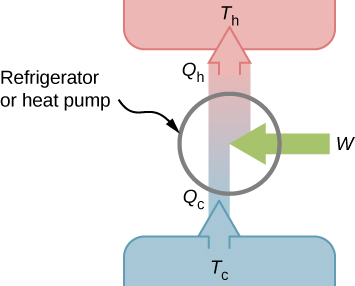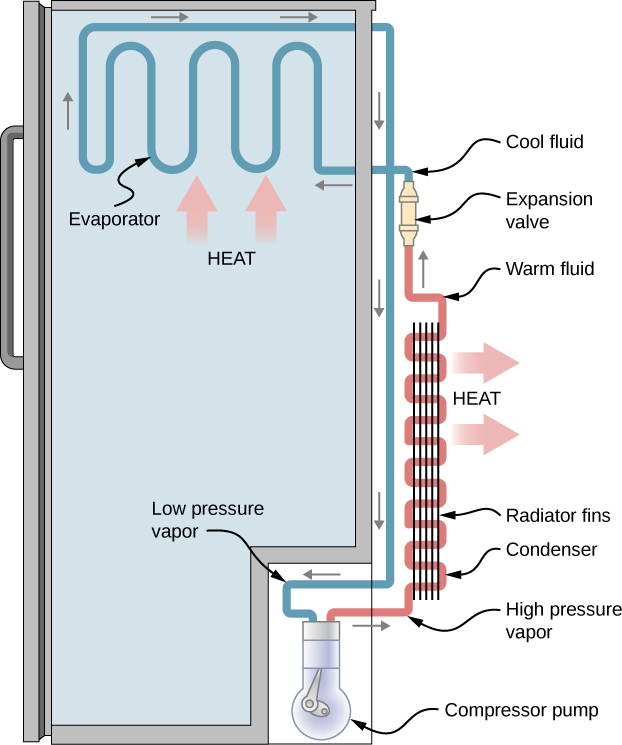4.4 : Réfrigérateurs et thermopompes
- Page ID
- 191126
À la fin de cette section, vous serez en mesure de :
- Décrivez un réfrigérateur et une thermopompe et énumérez leurs différences
- Calculer les coefficients de performance des réfrigérateurs et des pompes à chaleur simples
Les cycles que nous avons utilisés pour décrire le moteur dans la section précédente sont tous réversibles, de sorte que chaque séquence d'étapes peut tout aussi bien être exécutée dans la direction opposée. Dans ce cas, le moteur est appelé réfrigérateur ou pompe à chaleur, selon l'objectif : la chaleur évacuée du réservoir froid ou la chaleur déversée dans le réservoir chaud. Un réfrigérateur ou une thermopompe est un moteur qui tourne en marche arrière.
- Pour un réfrigérateur, l'accent est mis sur l'élimination de la chaleur d'une zone spécifique.
- Dans le cas d'une pompe à chaleur, l'accent est mis sur l'évacuation de la chaleur vers une zone spécifique.
Nous considérons d'abord un réfrigérateur (Figure\(\PageIndex{1}\)). Le but de ce moteur est d'évacuer la chaleur du réservoir de froid, qui est l'espace à l'intérieur du réfrigérateur pour un véritable réfrigérateur domestique ou l'espace à l'intérieur d'un bâtiment pour une unité de climatisation.

A refrigerator (or heat pump) absorbs heat \(Q_c\) from the cold reservoir at Kelvin temperature \(T_c\) and discards heat \(Q_h\) to the hot reservoir at Kelvin temperature \(T_h\) while work W is done on the engine’s working substance, as shown by the arrow pointing toward the system in the figure. A household refrigerator removes heat from the food within it while exhausting heat to the surrounding air. The required work, for which we pay in our electricity bill, is performed by the motor that moves a coolant through the coils. A schematic sketch of a household refrigerator is given in Figure \(\PageIndex{2}\).

The effectiveness or coefficient of performance \(K_R\) of a refrigerator is measured by the heat removed from the cold reservoir divided by the work done by the working substance cycle by cycle:
\[K_R = \dfrac{Q_c}{W} = \dfrac{Q_c}{Q_h - Q_c}\]
Note that we have used the condition of energy conservation, \(W = Q_h - Q_c\), in the final step of this expression.
The effectiveness or coefficient of performance \(K_P\) of a heat pump is measured by the heat dumped to the hot reservoir divided by the work done to the engine on the working substance cycle by cycle:
\[K_P = \dfrac{Q_h}{W} = \dfrac{Q_h}{Q_h - Q_c}.\]
Once again, we use the energy conservation condition \(W = Q_h - Q_c\) to obtain the final step of this expression.


